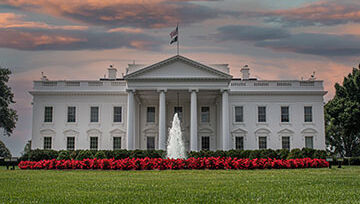On May 12, 2023, the U.S. Department of the Treasury (the Treasury) and Internal Revenue Service (IRS) Issued Notice 2023-38. The notice provides information and guidance on domestic content requirements for taxpayers to qualify for additional bonus amounts of certain energy credit incentives related to investments in and production of clean energy under Sections 45, 45Y, 48 and 48E.
The bonus credit incentives discussed in the notice are based on the amount of domestic content included in facilities and equipment used to produce clean energy. The domestic content rules are satisfied with respect to a qualified facility if the taxpayer certifies:
- Steel or iron construction materials that are structural components of a qualified facility have been mined or produced in the U.S. (except for certain metallurgical processes involving refinement of steel additives).
- 40% of total costs of manufactured products and equipment that are components of a qualified energy production facility are mined, produced or manufactured in the U.S. For offshore wind facilities, the threshold for domestic manufactured components is 20%. For facilities that begin construction after 2026, the required domestic content increases to 55%.
Increase in Credit Amount for Domestic Content
When the criteria for steel, iron or manufactured product components are met, the base tax credit may increase as follows:
| Energy Credit | Domestic Content Bonus Amount |
| Section 45: Electricity Produced From Certain Renewable Sources Section 45Y: Clean Electricity Production Credit |
10% increase in amount of base credit |
| Section 48: Energy Credit Section 48E: Clean Electricity Investment Credit |
10 percentage points increase in base credit if:
2 percentage points increase in base credit if: |
Notice 2023-38 provides a safe harbor regarding the classification of certain components in representative types of qualified facilities, energy projects or energy storage technologies. A table in the notice indicates whether certain components should be evaluated under the criteria for a steel or iron component, or the criteria for a manufactured product.
Taxpayers may rely on the guidance in Notice 2023-38 regarding the domestic content bonus credit requirements until the Treasury issues regulations.
Claiming the Domestic Content Bonus Credit
A certification must be attached to Form 8835, Renewable Electricity Product Credit, and filed in the year(s) in which the applicable credits are taken. The information to be included in the certification includes the type of energy project or facility, the type of energy technology used, the bonus content credit amount, as well as a signed statement from the taxpayer.
Background on the Energy Tax Credits
The Inflation Reduction Act (IRA) enacted on August 16, 2022, includes a significant expansion of the tax credits available for the production of clean energy, or for the installation of property used to generate clean energy. The four credits referenced in Notice 2023-38 are briefly described below.
Section 45: Electricity Produced From Certain Renewable Sources
The renewable electricity production credit for any taxable year is 0.3 cents per kilowatt hour of electricity produced by the taxpayer from a qualified energy resource at a qualified facility during the first 10 years of the facility’s life. Qualified energy resources include wind, geothermal, solar, qualified hydropower and other sources identified in section 45(c)(1). The credit amount is subject to inflation adjustments.
Section 45Y: Clean Electricity Production Credit
Beginning in 2025, the clean electricity production credit for any taxable year is 0.3 cents per kilowatt hour of electricity produced by the taxpayer at a qualified facility that is placed in service after December 31, 2024. The qualified facility must have a greenhouse gas emissions rate of zero. The credit applies to the first 10 years of the facility’s life. The credit amount is subject to inflation adjustments.
Section 48: Energy Property
Taxpayers are eligible for a tax credit for their investment in the costs of depreciable or amortizable energy property placed in service during the year. Energy property includes property and equipment acquired, constructed, reconstructed or erected by a taxpayer that:
- Uses solar energy to generate electricity, or to heat or cool a structure.
- Uses solar energy to illuminate the inside of a structure using fiber-optic distributed sunlight.
- Produces, distributes or uses energy derived from a geothermal deposit.
- Is qualified fuel cell or microturbine property.
- Is qualified small wind energy property.
- Uses energy storage technology that receives, stores and delivers energy.
In general, construction of new energy property must begin before January 1, 2024. The base credit for the energy sources identified above is six percent of qualified costs.
Property placed in service before 2022 is generally eligible for a credit of 30%, based on the investment in the energy property. For some energy property whose construction began after December 31, 2019, the credit rate was reduced to 26%.
Section 48E: Clean Electricity Investment Credit
Beginning in 2025, taxpayers can claim a credit for six percent of costs for construction, acquisition or installation of a qualified facility or energy storage technology. The qualified facility must generate electricity, have a greenhouse gas emissions rate of zero and be placed in service after December 31, 2024.
Bonus Credit Rates for Meeting Prevailing Wage and Apprenticeship Requirements
For each of the credits discussed above, an earlier notice from the IRS, Notice 2022-61, provided guidance for increasing the base credit rate by five times if one of these requirements is met:
- Maximum net output is less than one megawatt.
- Facility construction was started before January 29, 2023.
- Project satisfies the prevailing wage and apprenticeship requirements.
This is a separate bonus rate from the domestic content bonus rate discussed above. Notice 2022-61 focuses on the prevailing wage and apprenticeship requirements.
Let Us Guide You Forward
Reach out to our Cherry Bekaert’s Energy Tax Credits team if you have any questions on your eligibility for energy tax credits and how to apply.




